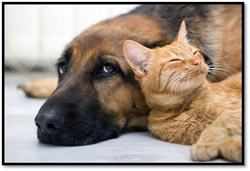Pollakiuria: Why is My Pet Urinating More Often Than Normal?
by Nancy Kay, DVM
 Pollakiuria is a fun word to pronounce (pol′ă-kē-yū′rē-ă) but it’s certainly not a fun symptom to deal with. Pollakiuria means increased frequency of urination. Dogs with this symptom ask to go outside more frequently than normal, often round the clock. The well house trained dog may begin leaving puddles in the house and cats with pollakiuria are in and out of the litter box with increased frequency. Some kitties abandon the box altogether choosing other places to urinate.
Pollakiuria is a fun word to pronounce (pol′ă-kē-yū′rē-ă) but it’s certainly not a fun symptom to deal with. Pollakiuria means increased frequency of urination. Dogs with this symptom ask to go outside more frequently than normal, often round the clock. The well house trained dog may begin leaving puddles in the house and cats with pollakiuria are in and out of the litter box with increased frequency. Some kitties abandon the box altogether choosing other places to urinate.
Pollakiuria caused by lower urinary tract disease
Pollakiuria is most commonly caused by abnormalities within the lower urinary tract, consisting of the bladder and urethra. The urethra is the narrow tube that transports urine from the bladder to the outside world.
Lower urinary tract disease may cause a dog or cat to sense the need to urinate well before their bladder is full, and the puddles produced are quite small. If ever you’ve experienced a bladder infection, no doubt you can relate to this sensation.
Common lower urinary tract maladies that cause pollakiuria include:
Pollakiuria caused by increased thirst
Some diseases causing pollakiuria are associated with increased thirst (polydipsia). Excess water intake and excess urine production (polyuria) go hand in hand. The animal drinks more, therefore the bladder fills more rapidly and frequently, and the puddles produced are quite large. Causes of increased thirst and urine production in dogs and cats include:
Some pollakiuric pets show overt symptoms (the kitty who urinates in the bathroom sink or the dog who leaves a bedside puddle for you to step in first thing in the morning). Other pets show more subtle symptoms. Be on the lookout for:
If such symptoms arise, I encourage you to schedule a visit with your veterinarian. Do your best to arrive with a full bladder (your pet’s that is) because testing a urine sample will be an important first step in arriving at a diagnosis. This is best accomplished by taking your kitty’s litter box away a few hours prior to the office visit. Likewise, avoid walking your dog before the visit, and get into the waiting room quickly so as to avoid those many tempting places to urinate just outside the clinic.
Has your pet ever experienced pollakiuria? If so, what was the cause determined to be?
CREDIT:
Dr. Nancy Kay, DVM Diplomate, American College of Veterinary Internal Medicine.
Recipient, American Animal Hospital Association 2009 Animal Welfare and Humane Ethics Award Recipient, 2009 Dog Writers Association of America Award for Best Blog Recipient, 2009 Eukanuba Canine Health Award
 Author of Speaking for Spot: Be the Advocate Your Dog Needs to Live a Happy, Healthy, Longer Life
Author of Speaking for Spot: Be the Advocate Your Dog Needs to Live a Happy, Healthy, Longer Life
Website: http://speakingforspot.com
Spot’s Blog: "http://www.speakingforspot.com/blog
Email: dr.kay@speakingforspot.com
Become a Facebook Fan: Facebook Fan - Nancy-Kay
 Pollakiuria is a fun word to pronounce (pol′ă-kē-yū′rē-ă) but it’s certainly not a fun symptom to deal with. Pollakiuria means increased frequency of urination. Dogs with this symptom ask to go outside more frequently than normal, often round the clock. The well house trained dog may begin leaving puddles in the house and cats with pollakiuria are in and out of the litter box with increased frequency. Some kitties abandon the box altogether choosing other places to urinate.
Pollakiuria is a fun word to pronounce (pol′ă-kē-yū′rē-ă) but it’s certainly not a fun symptom to deal with. Pollakiuria means increased frequency of urination. Dogs with this symptom ask to go outside more frequently than normal, often round the clock. The well house trained dog may begin leaving puddles in the house and cats with pollakiuria are in and out of the litter box with increased frequency. Some kitties abandon the box altogether choosing other places to urinate.Pollakiuria caused by lower urinary tract disease
Pollakiuria is most commonly caused by abnormalities within the lower urinary tract, consisting of the bladder and urethra. The urethra is the narrow tube that transports urine from the bladder to the outside world.
Lower urinary tract disease may cause a dog or cat to sense the need to urinate well before their bladder is full, and the puddles produced are quite small. If ever you’ve experienced a bladder infection, no doubt you can relate to this sensation.
Common lower urinary tract maladies that cause pollakiuria include:
- Bacterial infection within the bladder, aka bacterial cystitis: common in dogs, relatively uncommon in cats
- Stones within the bladder or urethra: common in dogs and cats
- Feline idiopathic cystitis (FIC)- an inflammatory condition of unknown cause affecting the bladder and/or urethra: purely cats
- Tumors or polyps within the bladder or urethra: relatively common in dogs, less common in cats
Pollakiuria caused by increased thirst
Some diseases causing pollakiuria are associated with increased thirst (polydipsia). Excess water intake and excess urine production (polyuria) go hand in hand. The animal drinks more, therefore the bladder fills more rapidly and frequently, and the puddles produced are quite large. Causes of increased thirst and urine production in dogs and cats include:
Recognizing pollakiuria
- Hormonal imbalances
–Diabetes mellitus: dogs and cats
–Diabetes insipidus: primarily dogs
–Hyperadrenocorticism (Cushing’s disease): primarily dogs Recognizing pollakiuria
–Hyperthyroidism: primarily cats
- Kidney disease
–Kidney failure: dogs and cats
–Pyelonephritis (kidney infection): dogs and cats
- Liver disease: dogs and cats
- Pyometra: primarily dogs
- Medications
–Cortisone containing products: primarily dogs
–Anti-seizure medications: dogs and cats
–Diuretics: dogs and cats
Some pollakiuric pets show overt symptoms (the kitty who urinates in the bathroom sink or the dog who leaves a bedside puddle for you to step in first thing in the morning). Other pets show more subtle symptoms. Be on the lookout for:
Increased frequency of urination on walks Increased number of puddles in the litter box A litter box that needs to be changed more frequently Interrupted sleep because your pet is asking to go outside The need to fill the water bowl more frequently than usual
If such symptoms arise, I encourage you to schedule a visit with your veterinarian. Do your best to arrive with a full bladder (your pet’s that is) because testing a urine sample will be an important first step in arriving at a diagnosis. This is best accomplished by taking your kitty’s litter box away a few hours prior to the office visit. Likewise, avoid walking your dog before the visit, and get into the waiting room quickly so as to avoid those many tempting places to urinate just outside the clinic.
Has your pet ever experienced pollakiuria? If so, what was the cause determined to be?
CREDIT:
Dr. Nancy Kay, DVM Diplomate, American College of Veterinary Internal Medicine.
Recipient, American Animal Hospital Association 2009 Animal Welfare and Humane Ethics Award Recipient, 2009 Dog Writers Association of America Award for Best Blog Recipient, 2009 Eukanuba Canine Health Award
 Author of Speaking for Spot: Be the Advocate Your Dog Needs to Live a Happy, Healthy, Longer Life
Author of Speaking for Spot: Be the Advocate Your Dog Needs to Live a Happy, Healthy, Longer LifeWebsite: http://speakingforspot.com
Spot’s Blog: "http://www.speakingforspot.com/blog
Email: dr.kay@speakingforspot.com
Become a Facebook Fan: Facebook Fan - Nancy-Kay
